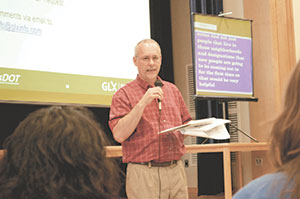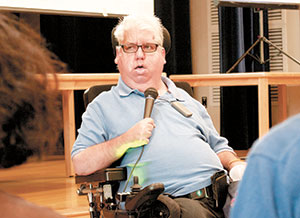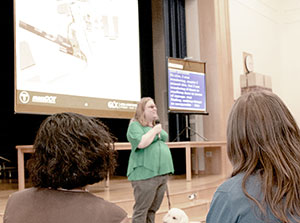
Last Thursday’s public meeting held by the MBTA allowed GLX project team members and concerned citizens review and discuss the impact of the Equivalent Facilitation request. — Photos by Douglas Yu
By Douglas Yu
In order to apply for funding for a Full Funding Grant Agreement with Federal Transit Administration (FTA), the GLX project team requested an Equivalent Facilitation that aims to permit the development of improvements in vehicle, facility, or equipment design that provides for equal or greater accessibility.
On Thursday, July 10, the MBTA held a public hearing to review the Equivalent Facilitation in Somerville.
Randy Henke from the GLX project team said that the project starts at Gilmore Bridge. “The Green Line Extension covers three communities: Cambridge, Somerville, Medford. Most of what we are hearing tonight is about roadways and traffic improvements in and around the new stations and how we can get to from the stations,” Henke said.
The important issues when it comes to roadways and traffic improvements have to do with running slope and cross slope, Henke said.
“We’ve got a bridge on Washington Street with approach on each side, and the approach is fairly steep. Again, the [construction] code calls for a 5 percent maximum [of slope]. Because we are in 7 hills of Somerville, the 15th densest populated area in the U.S. and the second densest area by population in New York City, we are trying to match it with the existing topography.” Henke said.

Executive Director of Disability Policy Consortium John Winske addressed accessibility issues.
Henke used the slope right outside the Argenziano School in Somerville as an example to explain the definition of cross slope. “The slope is running 7 percent. How can you get it to 2 percent without creating a ski jump for cars?” Henken said.
Other issues to address is that there are a couple of handrail extensions sticking out of the walkway, and the MBTA is looking for exceptions to get rid of them so it can ensure the safety of the pedestrians; the path of travel to the elevator at Gilman is slightly longer whereas the paths of travel is equal distance at every station.
The MBTA’s presentation about Equivalent Facilitation covers all the GLX stations that include the relocated Lechmere Station, accessible path issues at Washington Street Station, Union Square Station, Gilman Square Station, Lowell Street Station, Ball Square Station and College Avenue Station.
John Winske, Executive Director of Disability Policy Consortium suggested that the stations should have escalators go both directions. “We have a lot of troubles with accessibility in Somerville,” Winske said.
Medford resident Rachel Tanenhaus, said during the public testimony that the MBTA should test the signage near the stations to make sure there is not glare, for readability’s sake.
“Some of the stations are politely described as a cluster, and perhaps [the stations] are not so easy to navigate, so I’m glad that MBTA is looking at where the traffic is going.” Tanenhaus said. “I’d also like to make a recommendation in general. As someone with low vision, I always thought it would be awesome to paint a yellow dot or line near the bus stop, so you can see the shape of a T stop sign. Sometimes I miss the bus because I’m standing at the wrong place.”
Another Medford resident Ken Krause shared the similar thoughts with Tanenhaus about signage. “I identify the accessible pathway far in advance for someone who’s approaching, so they could avoid the slope. I also thought that Broadway Bridge is one of the bridges that are supposed to be rebuilt.”
The public is encouraged to send comments to the GLX Project through email and address, which are listed on the Equivalent Facilitation Request at http://greenlineextension.eot.state.ma.us/documents/PubMtgs/Equivalent_Facilitation_Request.pdf.













Reader Comments